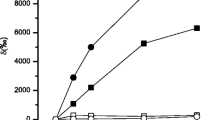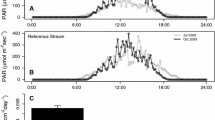Abstract
The quantitative significance of bacterial biomass in the nutrition of detritivores remains equivocal. We have used tritiated thymidine to specifically label stable macromolecules in natural assemblages of sediment-associated and detritus-associated bacteria. This material was presented to the isopod (Lirceus sp.) and incorporation of bacterial biomass measured. The isopod incorporated roughly 1 ng bacterial carbon (mg wet wt.)-1 h-1 from leaf discs and about 6 ng mg-1 h-1 from sediment. Calculation of grazing rate from changes in cell counts yields grazing rates from 2.3–17.9 ng C mg-1 h-1. Even the maximum grazing rate, which is an overestimate of C assimilated, represents only 14.7% of C respired by the isopod.
Similar content being viewed by others
References
Anderson J, Bignell D (1982) Assimilation of 14C-labelled leaf fiber by the millipede Glomeris marginata (Diplopoda, Glomeridae). Pedobiologia 23:120–125
Anderson N, Sedell J (1979) Detritus processing by macroinvertebrates in stream ecosystems. Ann Rev Entomol 24:351–377
Baker J, Bradnam L (1976) The role of bacteria in the nutrition of aquatic detritivores. Oecologia 24:95–104
Barlocher F, Kendrick B (1975) Assimilation efficiency of Gammarus pseudolimnaeus (Amphipoda) feeding on fungal mycelium or autumnshed leaves. Oikos 26:55–59
Cammen LM (1980) The significance of microbial carbon in the nutrition of the deposit feeding polychaete Nereis succinea. Mar Biol 61:9–20
Coull B, Vernberg W (1970) Harpacticoid copepod respiration: Enhydrosoma propinquum and Longipedia helgolandica. Mar Biol 5:341–344
Cummins K, Klug M (1979) Feeding ecology of stream invertebrates. Ann Rev Ecol Syste 10:147–172
Findlay S, Tenore K (1982) Nitrogen source for a detritivore: detritus substrate versus associated microbes. Science 218:317–373
Findlay S, Meyer J, Edwards R (1984) Measuring bacterial production via rate of incorporation of 3H-thymidine into DNA. J Microbiol Meth 2:57–72
Fuhrman JA, Azam F (1982) Thymidine incorporation as a measure of heterotrophic bacterioplankton production in marine surface waters: Evaluation and field results. Mar Biol 66:109–120
Golladay SW, Webster JR, Benfield EF (1981) Factors affecting food utilization by a leaf shredding aquatic insect: leaf species and conditioning time. Holarctic Ecology 6:157–162
Haines EB, Hanson RB (1979) Experimental degradation of detritus made from the salt marsh plants Spartina alterniflora Loisel, Salicornia virginica L., and Juncus roemerianus Scheele. J Exp Mar Biol Ecol 40:27–40
Harper RM, Fry JC, Learner MA (1981) Digestion of bacteria by Nais variabilis (Oligochaeta) as established by autoradiography. Oikos 36:211–218
Hobbie J, Daley R, Jasper S (1977) Use of nuclepore filters for counting bacteria by fluorescence microscopy. Appl Environ Microbiol 33:1225–1228
Hollibaugh JT, Fuhrman JA, Azam F (1980) Radioactively labeling of natural assemblages of bacterioplankton for use in trophic studies. Limnol Oceanogr 25:172–181
Iversen TM (1973) Decomposition of autumn-shed leaves in a spring-brook and its significance for the fauna. Arch Hydrobiol 72:305–312
Ivleva I (1982) The dependence of crustacean respiration rate on body mass and habitat temperature. Int Rev ges Hydrobiol 65:1–47
Karl D (1982) Selected nucleic acid precursors in studies of aquatic microbial ecology. Appl Environ Microbiol 44:891–902
Mann KH (1972) Macrophyte production and detritus food chains in coastal waters. Mem Inst Ital Hydrobiol 29 (Supply):353–382
Martin MM, Martin JS, Kukor JJ, Merritt RW (1980) The digestion of protein and carbohydrate by the stream detritivore, Tipula abdominalis (Diptera, Tipulidae). Oecologia (Berlin) 46:360–364
Moriarty D, Pollard P (1982) Diel variation of bacterial productivity in seagrass (Zostera capricorni) beds measured by rate of thymidine incorporation into DNA. Mar Biol 72:165–172
Newell SY, Christian RR (1981) Frequency of dividing cells as an estimator of bacterial productivity. Appl Envir Microbiol 42:23–31
Newell R, Field J (1983) The contribution of bacteria and detritus to carbon and nitrogen flow in a benthic community. Mar Biol Lett 4:23–36
Robinson J, Mann K, Novitsky J (1982) Conversion of the particulate fraction of seaweed detritus to bacterial biomass. Limnol Oceangr 27:1072–1079
Stuart V, Newell R, Lucas M (1982) Conversion of kelp debris and faecal material from the mussel Aulacomya ater by marine microorganisms. Mar Ecol Prog Ser 7:47–57
Vonk HJ (1960) Digestion and metabolism. In: Waterman TH (ed) The Physiology of Crustacea Vol. 1. Academic Press, New York London, pp
Whittaker RH, Likens GE (1973) Carbon in the biota In: Woodwell G, Pecan E (eds) Carbon and the Biosphere. United States Atomic Energy Commission. Springfield, Virginia, USA, pp 281–302
Author information
Authors and Affiliations
Rights and permissions
About this article
Cite this article
Findlay, S., Meyer, J.L. & Smith, P.J. Significance of bacterial biomass in the nutrition of a freshwater isopod (Lirceus sp.). Oecologia 63, 38–42 (1984). https://doi.org/10.1007/BF00379782
Received:
Issue Date:
DOI: https://doi.org/10.1007/BF00379782




